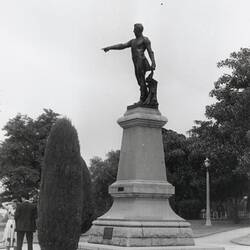William Light was born in 1786 in Kuala Kedah, Malaya. His mother was reported to be a princess of Kedah, but was probably a Portuguese Eurasian. His father was a trader, originally from England. Light spent his infant years on Penang, but at the age of six was sent to England to be educated by a friend of his father. He entered the navy as a volunteer at the age of 13, and left as a midshipman after two years. After spending time in India he returned to Europe, and in 1808 purchased a position in the cavalry and was promoted to lieutenant the following year. He served with distinction in the Spanish Peninsula war, drawing on linguistic skills to confer with guerilla bands. In 1812 he became a junior staff officer at Wellington's headquarters, and was employed on mapping, reconniassance and liaison duties. He endured more than forty battles without a wound. In 1814 he returned from Spain and purchased a captaincy in the infantry. He left the Army in 1821 with the brevet rank of major, and on 24 May married E. Perios in Londonderry.
Light was not long out of the Army when he served with the Spanish revoluntionary army at the rank of lieut-colonel. He was severely wounded in a scuffle for possession of Corunna. In 1824 he married again (it is unclear what happened to his first wife), this time to Mary Bennet, a duke's daughter. Her wealth was of particular benefit, and the couple travelled and sailed extensively in Europe. Some of Light's sketches were published in England. He separated from his wife in Egypt in 1832 when he found she had moved in with another man during his absence (she later had three children with her new partner) and returned to London in 1835. He was quickly appointed surveyor-general of South Australia and sailed three months later. He faced the impossible task to examine minutely 1,500 miles of coastline, select a location for a settlement, survey the town site, divide 150 square miles into sections and make reservations for secondary towns. He decided on a site on what would be known as the River Torrens, with a small natural harbour, fertile plains and nearby mountains. Governor Hindmarsh arrived at the site and was not pleased, particularly since it was six miles from the coast. Light pressed ahead, and to placate Hindmarsh surveyed 29 sections at Port Adelaide. Other surveys were impeded by colonists' efforts to move the settlement to Encounter Bay or Port Lincoln. Light also found his staff were inadequately experienced and equipped for the task of rural surveying and asked Britain for more support. David Elder claims Light asked for the removal of Hindmarsh, who was still trying to have the settlement moved, and that the request was refused (this claim requires further verification). When a temporary form of survey was proposed to speed up the work Light resigned.
Light now started his own business, Light, Finniss & Co. Meanwhile the surveying department fell into disarray and Hindmarsh was recalled to England. Moves in London and Adelaide to reinstate Light failed because he was now suffering from tuberculosis. In January 1839 Light bravely set out for a survey contract north of Adelaide, but he was forced to return the same day. The next afternoon his temporary dwelling was burnt down, with most of his life-time accumulation of papers, journals and sketches. He moved into his incomplete house, Therberton, living as an invalid. He was nursed by long-time companion Maria Grandy. He was desparately poor and sold sketches to make a little money. In May he struggled onto a horse again to search for a northerly route to the Murray, but it was a desparate last stance, and he returned from the trip in a severe fever. He died on 6 Octover 1839, aged 53.
References:
David F. Elder, 'Light, William (1786-1839)', Australian Dictionary of Biography, National Centre of Biography, Australian National University, https://adb.anu.edu.au/biography/light-william-2359/text3089, published first in hardcopy 1965.
More Information
-
Keywords
-
Localities
-
Authors
-
Article types


